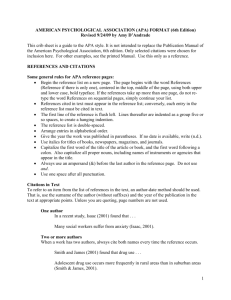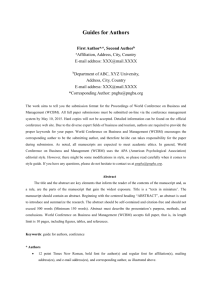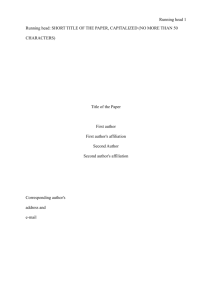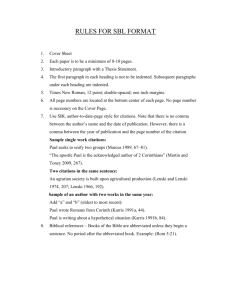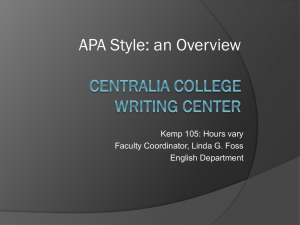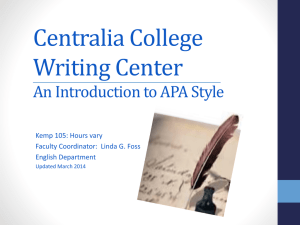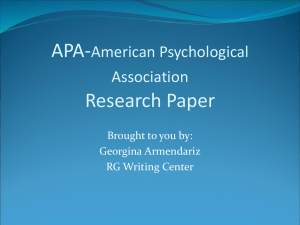APA
advertisement
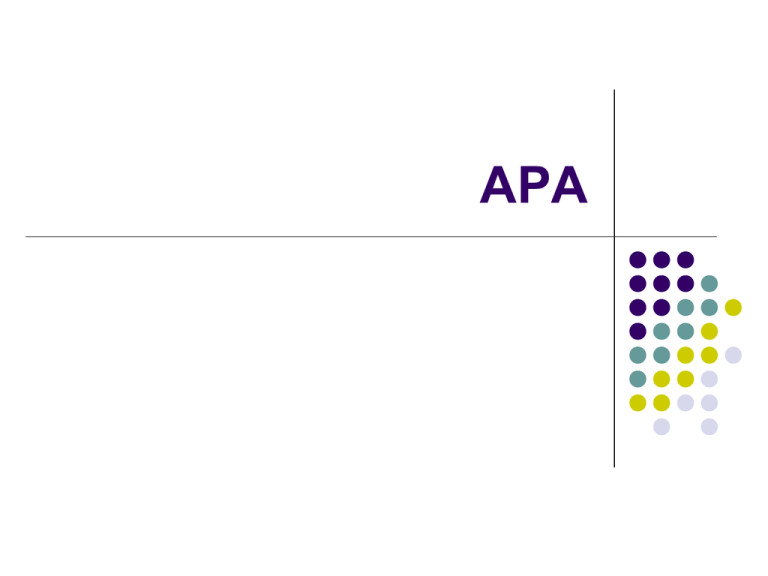
APA Formatting 1” margins Times New Roman font Double-spaced Running head in all caps at top left of every page Page number at top right of every page Writing Style Scientific writing does not have to lack style or be dull Present findings directly, but in a way that conveys involvement in the problem Address differing positions of researchers in a professional, non-combative way Use specific and concise language Avoid poetic or figurative language Vary sentence length and complexity to add interest Writing Style, cont’d Maintain continuity and smoothness of expression with punctuation, transitions, consistent verb tense Use third person, unless otherwise specified Use active voice as much as possible Be precise and clear Don’t add words for the sake of length Don’t repeat yourself for emphasis Avoid colloquialisms, which weaken meaning Avoid overusing jargon Guidelines for Reducing Bias Describe at the appropriate level of specificity When in doubt, be more specific rather than less Avoid terms that are loaded with innuendo, such as “at risk,” unless you are defining your use of the term. Be specific and sensitive when describing or discussing age, racial groups, sexual orientation, marital status, disabilities, etc. Guidelines for Reducing Bias, cont’d Be sensitive to labels Respect preferences – call people what they prefer to be called Remember that preferences can change over time and that individuals within groups may disagree Avoid labeling whenever possible Labels can cause participants in a study to lose their individuality and/or personhood Guidelines for Reducing Bias, cont’d Acknowledge participation Write about people in a way that acknowledges their participation and is consistent with the traditions of the field Accepted terms include “participants” and “subjects” Avoid the term “failed,” because it can imply a personal shortcoming rather than a research result Essential Parts Title Page Abstract Main Body References Title Page Running head Running head: TITLE OR SHORTENED TITLE The words “Running head:” only appear on the title page. Subsequent pages will only include the title Page number Centered on top half of the page: Title of Paper Name Institution Name Abstract Running head and page number in header “Abstract” centered on first line, first line of paragraph will not be indented 150-250 words, double-spaced Brief, comprehensive summary of paper Not an introduction to the paper Will not contain citations Main Body Title centered on top of first page Headings Citations Headings Used to separate sections of the paper and establish information hierarchy Use in order, beginning with Level 1 Level 1 Centered, Boldface, Uppercase and Lowercase Heading Level 2 Left-aligned, Boldface, Uppercase and Lowercase Heading Headings Level 3 Level 4 Indented, boldface, lowercase heading with a period. Indented, boldface, italicized, lowercase heading with a period. Level 5 Indented, italicized, lowercase heading with a period. In-Text Citations Used whenever directly quoting or paraphrasing from another author’s work When paraphrasing, use author, date format: A citation for a direct quote should also include a page number: (Author last name, year) (Author, year, p. #) Quotations 40 words or longer should be placed in a freestanding block If no author is given, used a shortened version of the title in the citation In-Text Citations If the publication date is unknown, use “n.d.” in its place For works with two authors, list both and use an ampersand: (Smith & Jones, 2010) For works with 3 or more authors, list all in the first citation: (Smith, Jones, & Brown, 2010), in subsequent citations, list the first author and “et al.”: (Smith et al., 2010) Classical works such as the Bible are only cited intext. Include the reference and version used: (1 Cor. 13:1, Revised Standard Version) References Include running head and page number Center “References” at the top of the page Every line after the first line of a reference entry should be indented one-half inch from the margin References are listed in alphabetical order by author name Authors are listed last name first, followed by first and middle initials References All titles except journal titles have only the first word capitalized Always capitalize proper nouns Capitalize the first word after a colon Article titles do not use quotation marks, underlines, or italics Book titles should be italicized Reference List Book Author, A. A. (Publication Year). Title of work: Subtitle. Location: Publisher. Separate multiple authors with commas Up to 7 authors For more than 7, follow with ellipsis (…), skip to last author, list final author Use an ampersand (&) instead of the word “and” Article in a periodical Author, A. A. (Year). Title of article. Title of Periodical, volume # (issue #), page #s. Reference List, cont’d Article from an online periodical (with DOI) The digital object identifier (DOI) is a reference number assigned to online periodical content Searchable in online databases (like an ISBN) Author, A. A. (Date). Title of article. Title of Online Periodical, volume # (issue #), pp-pp. doi:xx.xxxx Reference List, cont’d Article from an online periodical (without DOI) Author, A. A. (Date). Title of article. Title of Online Periodical, volume # (issue #), pp-pp. Retrieved from http://www.fullurl.com A web site Author, A. A. (Date). Title of document. Retrieved from http://www.fullurl.com APA Resources PowerPoint presentation http://www.liberty.edu/index.cfm?PID=12268 APA Manual Purdue’s Online Writing Lab http://owl.english.purdue.edu The Writing Centers Undergraduate Writing Center Office hours: M-F, 8 am – 5 pm undergradwriting@liberty.edu (434) 592-3174 Graduate Writing Center Office hours: M-F, 9 am – 5 pm graduatewriting@liberty.edu (434) 592-4727

